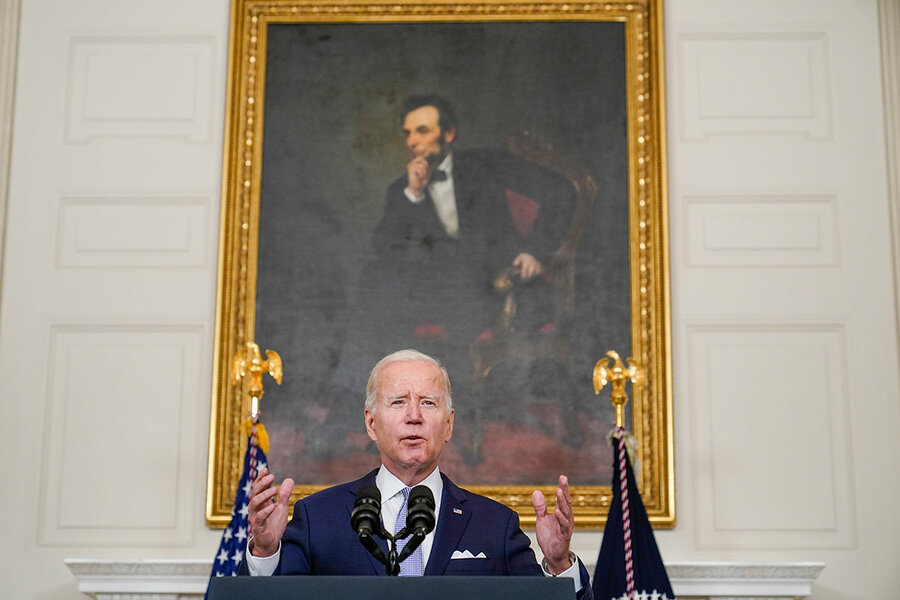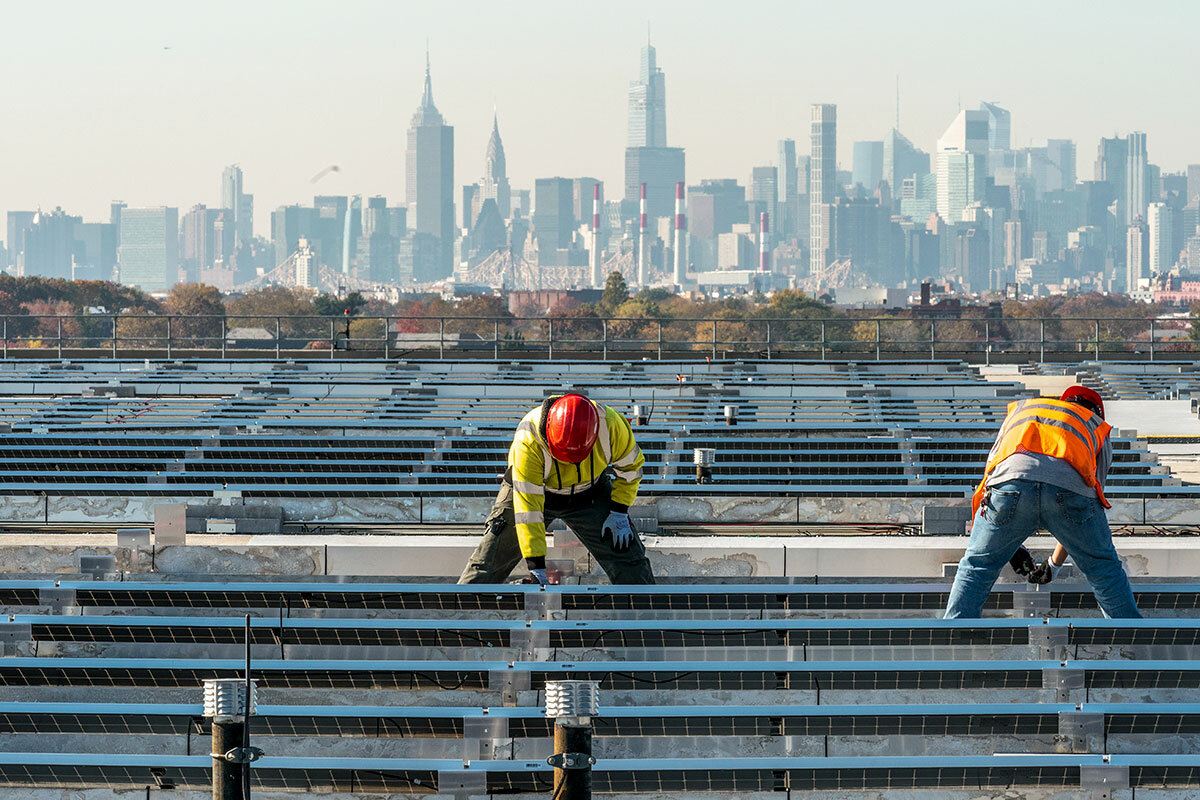Carrots not sticks? Senate bill may offer template for climate action.
Loading...
When Democratic lawmakers announced last week that they were a step closer to passing monumental climate change legislation, they gave new hope to activists who had been fretting that Congress was about to miss a key chance to fight global warming.
But the new Inflation Reduction Act of 2022 – a hard-fought and sweeping spending package that also addresses health care, taxes, and deficit reduction – does more than offer a long-sought win to climate advocates. It also offers a playbook for how to forge cooperation on difficult policy, and lessons for how to make countrywide progress in addressing climate change.
Advocates say the bill, with its $369 billion worth of investments in new green technologies and other initiatives, would be the largest federal climate action ever taken. It also reflects a careful balancing of ambition with political pragmatism: It balances economic needs with environmental achievement, spends more on incentives rather than imposing penalties, and focuses on optimism as opposed to ecological doom – attributes that many analysts say make it more palatable than some past climate efforts.
Why We Wrote This
Embedded in the Inflation Reduction Act is funding for cleaner electric power, electric and hydrogen vehicles, carbon capture technology, and more. Some analysts see a model here for climate progress.
“People will be employed by these provisions. People will save money. People will be able to move away from fossil fuels in their personal transportation,” says Daniel Bresette, executive director of the Environmental and Energy Study Institute in Washington, about the proposed law. “There is a way to do this where the future is better. We know what the future will be if we don’t do anything, and it’s unpleasant. A decarbonized, clean energy future represents an improvement. It’s not a sacrifice.”
“More politically durable, and therefore impactful”
The bill, which still needs to pass the Senate, is not yet a done deal. But many advocates say a climate package like the one proposed last week is more likely to pass, and to have staying power, than initiatives focused primarily around regulatory mandates and penalties.
“The more politically durable, and therefore impactful, policy is the carrot,” says Ryan Fitzpatrick, director of the Climate and Energy Program at Third Way, a center-left think tank.
This climate optimism came suddenly for Washington.
As recently as last week, activists were worried that the United States would be unable to reach its internationally pledged greenhouse gas emission reduction numbers. As heat waves and extreme weather events battered much of the Northern Hemisphere, pundits talked about the U.S. government’s ineffectiveness to combat climate change – an issue that the vast majority of Americans now label as a concern, according to polls.
Then the story changed.
“The narrative that Congress doesn’t work – I think that doesn’t really hold together right now,” says Sasha Mackler, who directs the Energy Program at the Bipartisan Policy Center. “On climate and energy issues, when they’re framed appropriately ... we can make progress.”
He points to both the Energy Act of 2020 and last year’s trillion-dollar bipartisan infrastructure bill as other points of important climate progress.
Still, for months, advocates have fretted that Democrats would lose control of the Senate before making any additional headway combating climate change. West Virginia Sen. Joe Manchin had been a thorn in the side of fellow Democrats trying to pass President Joe Biden’s climate priorities through a spending bill, saying as recently as last Tuesday that he would not support the climate package because of economic concerns.
A wide-ranging bill
But last week, Senator Manchin and Senate Majority Leader Chuck Schumer of New York announced they had reached an agreement on a law that analysts say could transform the country’s energy system. Their proposed funding for climate action includes billions of dollars in tax credits for power plants that use zero-emissions technologies, such as solar panels and wind turbines. There are incentives for electric vehicles, such as a $7,500 tax credit for most individuals looking to buy EV sedans or trucks. Billions of dollars will go to climate-friendly agriculture and to support new technologies such as carbon capture, which, in theory, could lock away carbon emissions from power plants so the heat-trapping gases don’t enter the atmosphere.
Together, analysts say, the incentives put the U.S. on track to reduce its carbon emissions by 40% compared with 2005 numbers by the end of the decade – roughly the pace needed to reach its internationally pledged climate goals.
“It’s been a really big turnaround in 24 hours,” said Christina DeConcini, director of government affairs at the World Resources Institute, last week. “Its importance can’t be underestimated. If it passes, it’s going to be the most significant climate action the United States has ever taken.”
There are still significant hurdles for the bill to become law. The bill needs all 50 Democrats in the Senate to support it, including Arizona Sen. Kyrsten Sinema, who has declined so far to say she would vote for the bill, and who over the weekend suggested she might demand changes or allow procedural maneuverings that would make passage more difficult. Republicans have criticized the climate-related funding as irresponsible in the face of other economic stressors. And some progressives have also opposed parts of the legislation, saying some provisions, such as compromises in the bill that connect leases for oil and gas drilling on federal land to clean energy initiatives, are going to put disproportionate harm on front-line communities.
“Legislation that supports measures to address the health of polluted communities on the one hand, while ramping up projects that increase pollution and unsafe practices on the lands of other frontline communities on the other ... is wrong,” said Bineshi Albert, co-executive director of the Climate Justice Alliance, in a statement last week. “Hard fought measures for Environmental Justice that support our communities are now being positioned alongside things that harm us, essentially holding us hostage to the needs of the fossil fuel industry. This will only harm us in the future.”
That position could impact a House vote, should the bill survive the Senate.
A path with future promise?
But the fact that such substantial climate initiatives have moved forward at all is crucial, advocates say.
“This bill represents an unprecedented investment in climate action,” says Lena Moffitt, chief of staff for Evergreen Action, a climate advocacy group. “It represents an important shift in climate policy. It’s not the bill we would have written, but it’s still essential and we need to get it passed. ... Will it solve the climate crisis full stop? No – we know that the fight goes on. But this [law] would be a clear indication that Congress takes this issue seriously.”
To Bob Inglis, a former Republican congressman from South Carolina who is now executive director of RepublicEN, a conservative climate organization that supports a carbon tax with border adjustment for imports, the bill’s efforts to support American manufacturing dovetail with a point he’s been making for years. The best way to build a stable climate future, he argues, is to build a strong, 21st-century, American economy. Investments today in emergent technologies such as clean hydrogen could put the U.S. at the forefront of future industry.
Indeed, he says, if many of the climate provisions in the bill stood alone, rather than wrapped up into the large package, he expects they would garner some Republican support.
“The expansion of the wind and solar credits, the exciting expansion, or creation, of additional credits in green hydrogen, the inclusion of hydrogen cars in electric car credits, the extension of the electric car credits – all those things are good,’ he says. “And I think they would have a lot of support among conservatives.”
Many Republican lawmakers have already been supporting green incentives and investments at the state level.
The big question now, Mr. Inglis says, is the same as the one progressives have posed.
“This is all great,” he says. “It’s not enough. The question now is, what do we do next?”







